A Comparative Analysis of the Rise of the Dutch, English, US, and Chinese Empires According to Ray Dalio
Ray Dalio, a renowned hedge fund manager, has written extensively about the "Big Cycle" in his book 'Principles for Dealing with the Changing World Order'. Dalio posits that these cycles have an average duration of roughly 250 years, divided into three main phases: the rise, the top, and the decline. Additionally, the transition periods between these cycles can span 10 to 20 years, during which the old world order gives way to the new.
Dalio's motive for researching these cycles stems from his desire to understand the underlying patterns and principles that govern the dynamics of global power shifts. By studying these cycles, he aims to provide insights into the factors that contribute to the rise and fall of nations, thereby offering valuable lessons for both policymakers and investors.
In this article, we will focus on the rising phase of this cycle and draw comparisons between four significant empires in history: the Dutch, English, US, and Chinese empires. Each of these empires exhibited common signs during their respective rising phases, which can serve as valuable lessons for understanding the dynamics of global power shifts.
“All the empires and dynasties I studied rose and declined in a classic Big Cycle that has clear markers that allow us to see where we are in it. This Big Cycle produces swings between 1) peaceful and prosperous periods of great creativity and productivity that raise living standards a lot and 2) depression, revolution, and war periods when there is a lot of fighting over wealth and power and a lot of destruction of wealth, life, and other things we cherish.”
― Ray Dalio, Principles for Dealing with the Changing World Order: Why Nations Succeed and Fail
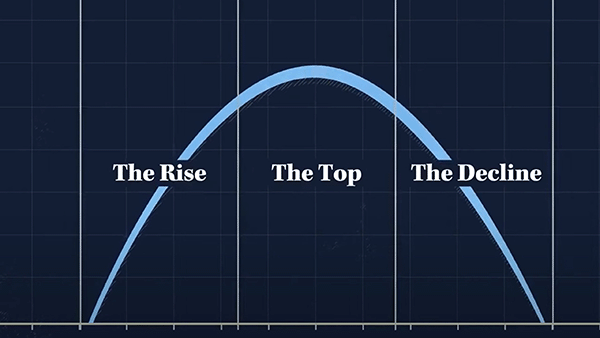
The three phases of Ray Dalio's Changing World Order 'Big Cycle'.
How the Rising Phase of an Empire Typically Begins
According to Ray Dalio, the inception of the rising phase in the Big Cycle often begins with the emergence of powerful revolutionary leaders. These leaders gain prominence and power by garnering more support than their opposition, often through a combination of charisma, vision, and strategic acumen. Once in power, they focus on consolidating their position by weakening or eliminating any opposition that could pose a threat to their rule. This consolidation is not merely an exercise in authoritarianism but a strategic move to create a stable environment for governance.
The leaders who emerge victorious in these power struggles are often adept at establishing systems and institutions that contribute to the effective functioning of the country. These can range from legal frameworks and economic policies to educational systems and healthcare services. The objective is to create a robust infrastructure that can support the nation's growth and development over the long term.
One of the most critical aspects of this phase, Ray Dalio noticed, is the ability of these leaders to either pick competent successors or establish systems that ensure the selection of capable leaders. This is crucial for the continuity of the policies and systems that have been put in place, ensuring that the nation continues to prosper even after the initial leaders have moved on or passed away.
The combination of these factors—strong leadership, consolidation of power, effective governance systems, and the successful transition of leadership—creates a virtuous cycle that leads to a period of peace and prosperity. This sets the stage for the nation or empire to enter the rising phase of the Big Cycle, where it begins to accumulate the economic, technological, and military capabilities that will eventually make it a dominant global power and huge empire.
Results Seen in the Rising Phase of an Empire
In the rising phase of the Big Cycle, as outlined by Ray Dalio, one of the most tangible and impactful results is the improvement in education. This is not merely an academic exercise but a comprehensive approach to human development that goes beyond imparting knowledge and skills. According to Dalio, a strong educational system aims to develop not just intellectual capabilities but also strong character, civility, and work ethic. These values are often instilled not just through formal schooling but also within families and religious institutions.
The emphasis on character education serves a broader societal purpose. It instills a respect for rules and laws, thereby contributing to societal order and stability. This environment of low corruption and high ethical standards allows people to unite behind a common purpose and work well together. When a society has a strong foundation of trust and shared values, its members are more likely to collaborate effectively, leading to economic prosperity and social cohesion.
One of the most significant outcomes of this educational and ethical foundation is the capacity for innovation. When people are educated not just to be skilled but also to be ethical and civic-minded, they are more likely to engage in activities that benefit society as a whole. This extends to the economic realm, where an educated and ethical populace is more likely to produce beyond basic commodities. They are equipped to innovate, create, and invent new technologies that can propel the nation or empire into a position of global leadership.
Societal order, higher education, and the freedom to innovate increase the power and influence of an empire, inexplicably increasing trade with the rest of the world. As the empire's wealth grows, a strong military is needed to protect the empire's interests. If the empire's growth is unopposed or solidified through victories over rival empires, a new world order is established through the leading empire.
Common Signs of the Rising Phase in Empires
According to Dalio’s research, the rising phase of the Big Cycle serves as a pivotal chapter that sets the stage for empires to ascend to the zenith of their power. During their respective periods of rise, each of these empires exhibited a set of common signs that included economic prosperity, technological advancements, strong governance, and military prowess. Dalio examined the commonalities between the Dutch, English, US, and Chinese empires to shed light on the key factors that contributed to the rise of empires and offer a comparative analysis that transcends time and geography.
Economic Prosperity Through Capitalism
Capitalism has been a common thread in the economic prosperity of various empires, including the Roman Empire and Persian Empire, during their respective rising phases.
The Dutch Empire, during its Golden Age, was a pioneer in modern capitalism, with the establishment of the Dutch East India Company as one of the world's first joint-stock companies. This laid the groundwork for the Amsterdam Stock Exchange and modern financial systems.
Similarly, the English Empire thrived on mercantilism and later industrial capitalism, which fueled its colonial expansion and global trade networks.
The United States, during its rise, saw the growth of industrial capitalism, facilitated by technological innovations and the emergence of the military-industrial complex, which became a significant driver of economic growth.
China has embraced a unique form of state capitalism in the last two decades, where the government plays a significant role in guiding economic development. This has led to rapid industrialization, technological advancements, and a booming middle class, positioning China as the world's second-largest economy.
In each of these cases, capitalism, albeit in different forms, has been instrumental in driving economic prosperity and contributing to the rise of these empires.
“As a natural consequence, all of the greatest empires developed the world’s leading financial center for attracting and distributing the capital of their times. Amsterdam was the world’s financial center when the Dutch were preeminent, London was when the British were on top, New York is now, and China is quickly developing its own financial center in Shanghai.”
― Ray Dalio, Changing World Order: Why Nations Succeed or Fail
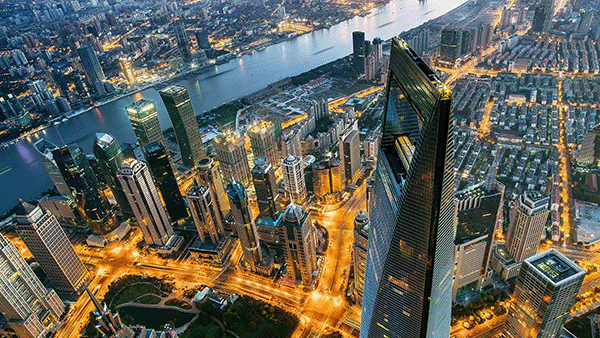
Shanghai, China's financial center
Technological Advancements
Dutch Empire: During the Dutch Golden Age, which spanned the 17th century, the Netherlands was a hotbed of innovation and invention that significantly impacted global trade, science, and finance. The Dutch developed the Fluyt ship, a more economical and cargo-friendly merchant vessel that gave them an edge in global trade. In the realm of science, they made significant improvements to the telescope, enhancing its capabilities for astronomical observations.
Cartographically, Dutch atlases set new standards for accuracy and detail, aiding navigation and exploration. The iconic windmills, a symbol of Dutch ingenuity, were used extensively for land reclamation and hydraulic engineering. Financially, the establishment of the Dutch East India Company as one of the world's first joint-stock companies and the creation of the Amsterdam Stock Exchange in 1602 laid the foundations for modern capitalism.
Additionally, the Bank of Amsterdam served as a precursor to modern central banking systems, setting the stage for financial stability and growth.
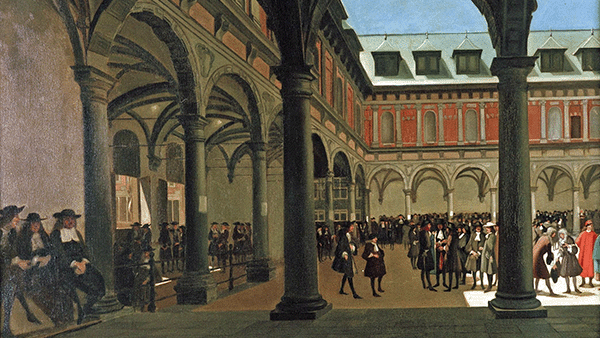
Amsterdam Stock Exchange, c. 1612
English Empire: Between the late 16th to the early 18th centuries, England was a crucible for groundbreaking inventions and discoveries that shaped the modern world. Sir Isaac Newton's laws of motion and universal gravitation, collectively known as Newtonian Physics, revolutionized our understanding of the natural world.
Technological advancements like the steam engine, refined by inventors like Thomas Newcomen and James Watt, became the driving force behind the Industrial Revolution. John Harrison's invention of the Chronometer revolutionized maritime navigation by providing accurate timekeeping at sea.
In the medical field, Edward Jenner's development of the Smallpox Vaccination was a life-saving breakthrough. Financially, the establishment of the East India Company as a joint-stock company, the founding of the Bank of England in 1694, and the creation of the London Stock Exchange laid the foundations for modern capitalism and financial systems. These innovations had a profound and lasting impact, not just on England, but on the entire world.
US Empire: The post-World War II era saw the United States emerge as the world's leading economic power. Groundbreaking American inventions between the late 19th and early 20th centuries forever altered the course of human history.
Thomas Edison's practical light bulb revolutionized indoor lighting, while Alexander Graham Bell's telephone transformed long-distance communication. The Wright brothers' pioneering work in aviation led to the invention of the airplane, and Henry Ford's assembly line made automobiles accessible to the general public.
In the realm of science, Albert Einstein's theory of relativity, developed while he was at Princeton University, reshaped our understanding of the universe.
Medical advancements were equally groundbreaking, with the mass production of insulin in the U.S. revolutionizing diabetes treatment and Jonas Salk's polio vaccine nearly eradicating the disease. Additionally, the development of steel-frame construction techniques enabled the rise of skyscrapers, transforming the American urban landscape.
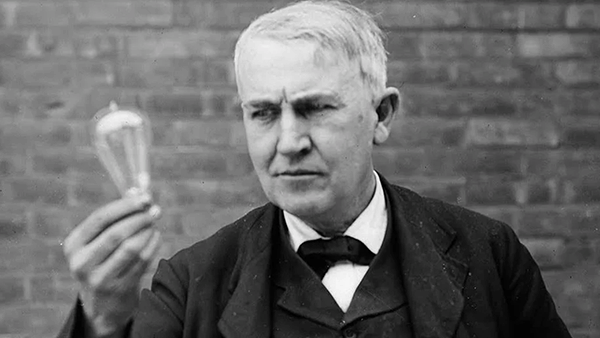
Thomas Edison built his first high resistance, incandescent electric light by January 1879.
Chinese Empire: China's economic reforms in the late 20th century have led to unprecedented growth, making it the world's second-largest economy. China has solidified its position as a global innovation powerhouse, making remarkable advancements across multiple sectors.
The country has led the way in 5G technology, with companies like Huawei pioneering its global rollout. In artificial intelligence, Chinese tech giants such as Baidu, Alibaba, and Tencent have made groundbreaking contributions, from natural language processing to autonomous driving.
China's significant investments in quantum computing aim to set new standards in secure communication and data processing.
The nation's high-speed rail network is the largest and among the most advanced in the world.
In the medical arena, Chinese researchers have been at the forefront of CRISPR gene editing technology. China is also a global leader in green technologies, notably in the production of solar panels and the development of electric vehicles (EVs) through companies like BYD and NIO.
In the financial sector, digital payment platforms like Alipay and WeChat Pay have revolutionized transaction methods, making cashless payments a norm across China.
In space exploration, China has not only landed a rover on the far side of the Moon but is also in the process of constructing the Tiangong Space Station.
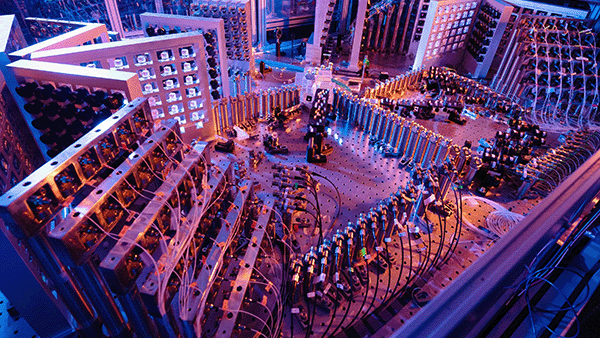
Chinese optical quantum computer Jiuzhang 2.0
Strong Governance
Dutch Empire: The Dutch Republic was characterized by a decentralized federation of provinces, each with a high degree of autonomy, united under the States General. This system allowed for a balance of power and encouraged economic competition among the provinces, fostering an environment conducive to trade and innovation.
The Dutch also established one of the earliest forms of a joint-stock company, the Dutch East India Company, which was granted monopolistic trading rights and had its own governance structures, demonstrating a sophisticated understanding of corporate governance.
English Empire: The English governance system evolved significantly, particularly with the establishment of constitutional monarchy and the strengthening of parliamentary democracy. The Magna Carta, the Petition of Right, and the Bill of Right laid the legal foundations for individual liberties and checks on royal power, setting precedents that would influence governance models worldwide. These governance innovations were instrumental in creating a stable environment that allowed for economic growth, colonial expansion, and advancements in science and technology.
US Empire: The United States, during the late 19th and early 20th centuries, benefited from a strong governance model rooted in the principles of democracy and federalism. The system of checks and balances among the executive, legislative, and judicial branches of government ensured that no single entity could wield unchecked power, promoting stability and rule of law. This governance model was conducive to innovation and economic growth, as it encouraged entrepreneurship while providing a legal framework that protected property rights and contracts.
Chinese Empire: In the last two decades, China has exhibited strong governance through a centralized, one-party system led by the Communist Party of China (CPC). This centralized governance model has allowed for rapid decision-making and implementation of policies, enabling China to quickly adapt to global economic trends and technological advancements.
The government has also invested heavily in strategic sectors like technology, green energy, and infrastructure, guided by long-term plans such as the "Made in China 2025" initiative and the Belt and Road Initiative. This focus on long-term planning and investment demonstrates a governance model that is highly strategic and geared towards positioning China as a global leader in various fields.
Military Power
Dutch Empire: During the Dutch Golden Age, the Dutch navy was one of the most powerful in the world, securing trade routes and colonial territories.
The Dutch were pioneers in naval warfare tactics and shipbuilding, with innovations like the "line of battle" formation and the development of the Fluyt ship. This naval prowess allowed the Dutch to establish and maintain a global trading empire, which included valuable colonies in Asia, Africa, and the Americas.
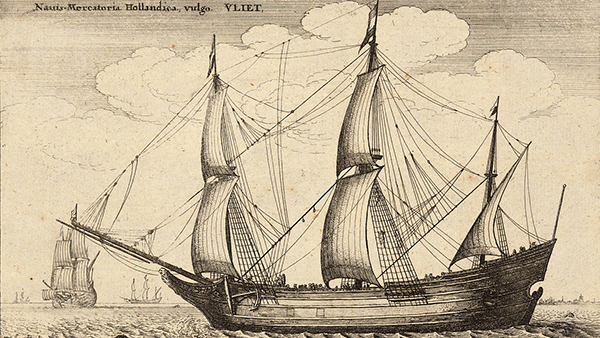
Dutch fluyt
English Empire: The English military, particularly the Royal Navy, was a cornerstone of its global empire. The defeat of the Spanish Armada in 1588 marked a turning point, establishing England as a dominant naval power. This military strength enabled England to protect its trade routes, expand its colonies, and exert influence over other nations, laying the foundation for the British Empire.
US Empire: In the late 19th and early 20th centuries, the United States saw a rapid expansion of its military capabilities, bolstered by technological advancements like machine guns, tanks, and aircraft.
This period also laid the groundwork for the emergence of the military-industrial complex, a symbiotic relationship between the U.S. military and the industrial sector that produces its arms and equipment. This complex became a significant driver of the American economy and played a crucial role in the United States' rise as a global power, enabling it to exert influence far beyond its borders and play a decisive role in world events.
Chinese Empire: China has undertaken significant efforts in the past two decades to modernize and expand its military capabilities. The People's Liberation Army (PLA) has seen extensive reforms, including the development of advanced technologies like stealth fighters, aircraft carriers, and hypersonic missiles. Notably, the size of the Chinese military is one of the largest in the world, surpassing that of the United States in terms of personnel and military hardware. This military modernization and expansion are integral to China's broader strategy to assert itself as a global power, capable of regional security and global power projection.
History Rhyming Again
The rising phase of Ray Dalio’s Big Cycle in changing world orders is a complex and multifaceted period that sets the stage for an empire's peak and eventual decline. The Dutch, English, US, and Chinese empires each exhibited common signs during their rising phases, including economic prosperity, technological advancements, strong governance, and military power.
It is often said that while history may not repeat itself, it certainly rhymes. Understanding these patterns can provide valuable insights into the dynamics of global power shifts and the factors contributing to empires' rise.
Careful study of these patterns allows better anticipation of the future trajectories of emerging powers and the global implications of their rise. As Ray Dalio suggests, anticipate the future by studying the past.
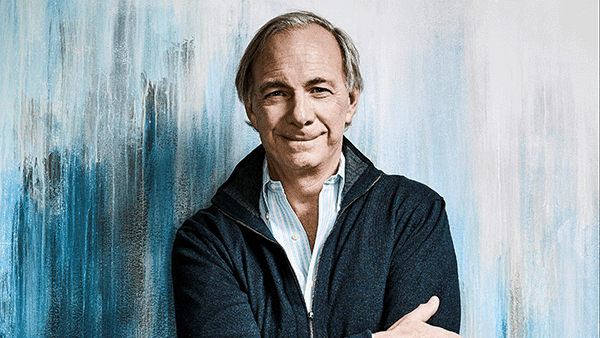
Ray Dalio, author of "Principles for Dealing with the Changing World Order".
Protect Your Wealth With Physical Precious Metals Amidst Global Uncertainty
In light of Ray Dalio's insights on the rising phase of empires, it is prudent for individuals and investors to consider the value of diversifying their portfolios. As a challenger nation arises, the incumbent superpower is also on the decline. As history has shown, this period often brings uncertainties and shifts in global power dynamics as the uncompetitive incumbent superpower goes out of its way to suppress the competitive rising challenger.
In these times of economic flux and rising uncertainties, safeguarding your wealth becomes paramount. Explore our range of precious metals, such as gold bullion bars and silver bullion bars, to secure your investments against the unforeseen. Alternatively, you can buy gold coins and silver coins as well. Discover the stability and security of tangible assets and navigate the changing tides with confidence. Contact us today to learn more about our services and how we can assist you in preserving and growing your wealth during times of global shifts and economic expansions.
Read "The Rising Phase of Empires" >>
